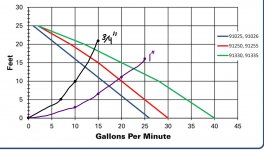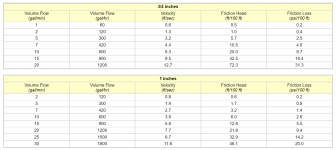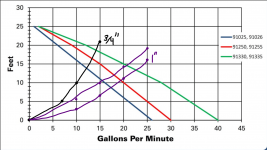Mechanical Engineer here. When they talk about 25 ft, they're talking about vertical lift (height), not horizontal distance. The head pressure to flow rate relationship for pumps is always identified by their pump curve. Yours can be found in your manual. I also located it
here. Looking at your pump curve, at the maximum head of 25 ft, you will get 2 gpm. After that, the pump will stall. At zero head (no pressure), your pump will deliver 40 gpm. The head pressure will be determined by two things, your "static head" which is essentially the height above the surface of the water in your pool you are trying to pump plus the "dynamic head" which is the pressure loss caused by the friction of the water moving through your garden hose. So the shorter you make your hose, the better. But let's go with the 50 foot of garden hose you mentioned.
Let's make a few assumptions: Let's assume you aren't pumping "uphill" and are merely lifting the water from the surface of your pool to the ground. We can conservatively estimate the "static head" to be 2' (probably less). Based on the pump curve, and interpolating between the 5 psi and 0 psi points, we can estimate your pump can deliver approximately 37.6 gpm of flow at a static head height of 2' with NO HOSE attached.
Now, determining the dynamic head is a little more tricky because the length of the hose determines the pressure drop, but the pressure drop influences the flow. So this solution has to be done iteratively. I found a nice little irrigation calculator
here. We will plug the starting pressure which will give us a flow rate, we will then look up the pressure at that flow rate on the pump curve, and plug it back into the calculator. We will repeat this until the flow rate determined by the calculator no longer changes.
After plugging several values into the calculator 12.5 gpm will give just under 20 foot of head which, on the pump curve yields about 12.5 gpm. This is the point of zero error. Add your 2' of static head and you will be at roughly 20' of head pressure on the pump which will give you 12 gpm exactly. We could break out formulas and get a lot more accurate, but this will suffice for the kind of estimate we're doing.
So expect about 12 gpm out of your little pump. To drain half of your 12,500 gallon pool, you can expect it to take about 8 hours 45 minutes.
Hope that was helpful.





